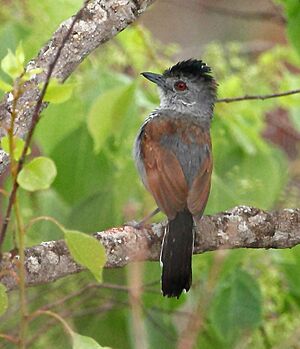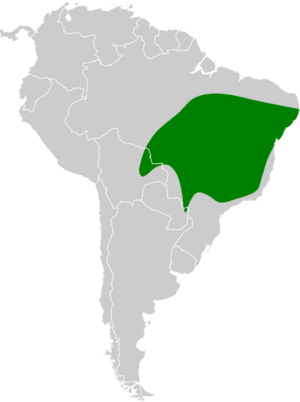Rufous-winged antshrike facts for kids
Quick facts for kids Rufous-winged antshrike |
|
|---|---|
 |
|
| Conservation status | |
| Scientific classification | |
| Genus: |
Thamnophilus
|
| Species: |
torquatus
|
 |
|
The rufous-winged antshrike (scientific name: Thamnophilus torquatus) is a cool bird found in parts of South America. It lives in countries like Bolivia, Brazil, and Paraguay. This bird is part of a group called "typical antbirds." They are known for their strong, hooked beaks.
Contents
About Its Name
The rufous-winged antshrike got its scientific name, Thamnophilus torquatus, from an English scientist named William Swainson in 1825. This bird is very closely related to the rufous-capped antshrike. Scientists are even thinking about grouping them as the same species.
What It Looks Like
The rufous-winged antshrike is about 14 centimeters (5.5 inches) long. It weighs between 18 and 20 grams (about 0.6 to 0.7 ounces). Birds in the Thamnophilus group are fairly large antbirds. They all have strong beaks that look like a hook, similar to a true shrike bird.
Males and Females Look Different
Male and female rufous-winged antshrikes look quite different. This is called sexual dimorphism.
- Adult males have a black top of the head and a gray face, neck, and upper body. Their wings are a reddish-brown color, like cinnamon. Their tail is black with white stripes on the outer feathers. Their throat and belly are whitish with black stripes on the chest.
- Adult females have a reddish-brown top of the head. Their face is a mix of white and gray. Their upper body is a light reddish-brown. Their wings look like the male's. Their tail is reddish-brown. Their belly is a light tan color, darker on the chest and sides. Sometimes, females have faint dark stripes on their chest.
Where It Lives
The rufous-winged antshrike lives in Brazil, from the southern part of Pará all the way east to Pernambuco. Its range goes south to the state of Rio de Janeiro. In the western part of its range, it lives in Mato Grosso and Mato Grosso do Sul. From there, it continues into eastern Bolivia and eastern Paraguay.
Its Home
This bird likes to live in the lower parts of cerrado areas. These are like savannas with scattered trees. It also lives in nearby forests that lose some leaves in dry seasons. You can also find it in brushy gallery forests, which grow along rivers. It likes places where plants have grown back, like old pastures or farms. It usually lives below 1,000 meters (3,300 feet) in elevation. But sometimes, it can be found as high as 1,750 meters (5,740 feet).
Behavior
Movement
The rufous-winged antshrike is thought to stay in the same area all year long. It does not migrate.
What It Eats
We don't know all the details of what the rufous-winged antshrike eats. But it mostly eats insects and other small creatures with many legs, like spiders. It usually looks for food alone or in pairs. It mostly stays in the lower parts of plants, usually within 2 meters (6.5 feet) of the ground. Sometimes, it goes higher into the treetops.
It hops through plants, picking bugs off leaves, stems, and branches. It might also fly up a short distance from where it's sitting to catch prey. Sometimes, it even drops to the ground to pick up food from fallen leaves. This bird sometimes joins groups of different bird species that are all looking for food together.
Life Cycle
Rufous-winged antshrike nests have been found between April and June. Both the male and female birds help build the nest. It's shaped like a cup and is made mostly of grass, small roots, and parts of fungi. Sometimes, they add moss, bark, or even human-made string. The nest hangs in a fork of a branch, usually about 0.7 to 1.5 meters (2 to 5 feet) above the ground.
They usually lay two eggs, but sometimes they lay three. Both parents take turns sitting on the eggs to keep them warm. They also both feed the baby birds once they hatch. The eggs hatch after about 15 days. The young birds leave the nest about 10 days after hatching.
Its Sounds
The song of the rufous-winged antshrike is a series of sounds that get faster. It starts with one long, drawn-out sound. Then, it makes shorter sounds that get quicker. It ends with a longer sound that goes down in pitch. Its other calls include a "whistle" that goes up in pitch, a "nasal" sound that becomes rough, and a "growl."
Status
The IUCN (International Union for Conservation of Nature) says the rufous-winged antshrike is a species of "Least Concern." This means it is not currently in danger of disappearing. It lives in a very large area. We don't know exactly how many of these birds there are, but their numbers seem to be going down. However, no immediate big threats have been found.
It is generally thought to be uncommon to fairly common. In some areas, it might only be found in a few spots. It lives in several large protected areas. It also seems to be able to live in places where plants have grown back after being cleared. This means it's not as sensitive to changes in its habitat.


